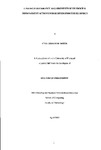LINKING PERFORMANCE REQUIREMENTS WITH PROCESS IMPROVEMENT ACTIONS FOR BUSINESS PROCESS RE-DESIGN
| dc.contributor.author | WOOD, CITA LORRAINE | |
| dc.contributor.other | Faculty of Science and Engineering | en_US |
| dc.date.accessioned | 2013-10-22T10:17:37Z | |
| dc.date.available | 2013-10-22T10:17:37Z | |
| dc.date.issued | 2002 | |
| dc.identifier | NOT AVAILABLE | en_US |
| dc.identifier.uri | http://hdl.handle.net/10026.1/2278 | |
| dc.description.abstract |
This thesis presents research that extends current knowledge in the area of business process re-design, with a specific focus on the 'Make Product' process within manufacturing organisations. Current business process re-design approaches offer only limited guidance on the specific changes that can be made to a process when re-designing it to achieve the desired performance improvements and often overlook any strategically derived performance requirements when re-designing the process. Case experience suggests that practitioners do not consider the performance requirements of their business processes when re-designing them and that the actions they take to achieve performance improvements are not selected with regard to any strategically derived performance requirements. This exploratory research investigates whether relationships can be established between the changes that can be made to a process when re-designing it and the performance improvements gained by implementing those changes. It then questions whether those relationships can be used to help companies to select the appropriate process changes to implement in order to meet their specific performance requirements. Performance Requirements and process changes (Process Improvement Actions) were derived from the relevant literature and included in a questionnaire designed to ascertain the strength of relationships between them. The questionnaire was subject to preliminary and pilot testing to improve validation and reliability prior to being administered to international business process re-design 'experts'. Statistical analysis of the questionnaire data resulted in a ranked list of Process Improvement Actions for each of the Performance Requirements. These were presented in a format for inclusion in a process-based change handbook and enable the practitioner to set the agenda for the intervention and select the Process Improvement Actions on the basis of the Performance Requirements. The Performance Requirements should be derived from the strategy of the company or change programme so a strategic focus is maintained throughout re-design. It was also found that of the thirteen Process Improvement Actions included in the questionnaire just five are needed to achieve improvements in a majority (80%) of the performance requirements. This research showed that it is possible to establish links between Performance Requirements and Process Improvement Actions and according to successful validation by practitioners, against an accepted model, that these can be used for business process re-design, laying foundations for future research in the area. | en_US |
| dc.language.iso | en | en_US |
| dc.publisher | University of Plymouth | en_US |
| dc.title | LINKING PERFORMANCE REQUIREMENTS WITH PROCESS IMPROVEMENT ACTIONS FOR BUSINESS PROCESS RE-DESIGN | en_US |
| dc.type | Thesis | |
| dc.identifier.doi | http://dx.doi.org/10.24382/3946 |
Files in this item
This item appears in the following Collection(s)
-
01 Research Theses Main Collection
Research Theses Main


